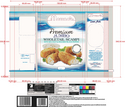Partners in time
6 July 2010Whilst they may compete in outputting, flexo and digital technologies are also working in combination to produce an optimum solution, reports Sam Cole.
Flexo and digital – are they in competition or in cahoots? As with the UK’s new brand of coalition politics, the answer is both. In terms of outputted print, they’ve been battling it out head to head for quite some time on short-run narrow web applications, and increasingly will be for volume production as inkjet matures into a viable alternative. But behind the scenes, flexo’s dependency on digital technology is of paramount importance in terms of enabling the process to extend its reach by building upon existing market share.
The real challenge for flexo has always been to match or better offset and gravure quality and capability as the industry benchmark. On its own, it is unlikely to ever attain that standard; hence, the evolving flexo process is the sum total of a number of different technologies working to their strengths towards delivering cost and performance-competitive packaging print applications.
Aside from the mechanical engineering of the press itself, flexo has been a long-time dependent upon digital technology to bring it fully up to speed; not least in plate production. Since it was first introduced 15 years ago, the Cyrel digital imager (CDI) is now reckoned to be the means of production of over 90% of all digital flexo plates used worldwide, with EskoArtwork recently installing its 1,500th system at US-based VT Graphics.
Esko focused upon two notable developments in digital flexo plate technology at the recent IPEX show: the CDI Advance Cantilever 1450, designed for imaging large-format sleeves as well as seamless and endless sleeves for flexible packaging applications; and its HD Flexo solution, whose combination of high resolution 4,000dpi optics and exceptional screening properties makes it possible to achieve outstanding print quality with a straightforward plate production process and is said to be enabling early adopters to reproduce the full tonal range of offset.
Equally significant, the HD Flexo technology is very easy to use, as it no longer requires any adjustments. Moreover, the rounder dot shape facilitates greater stability on the press, resulting in longer print runs with the same printing plate - more so than standard digital flexo plates. With longer print runs, the press stops less often for wash-ups, resulting in greater productivity. HD Flexo brings significant sustainability benefits as well, as it avoids any manual lamination of the plate. Therefore, there is no film to dispose of once the plates have been imaged.
By using thermal technology for the processing of the plates, there is no need to use solvents, which are potentially damaging to the environment. According to Esko, printers who work with plates generated from HD Flexo can typically expect to reduce makeready sheets required to get to acceptable colour by 66%, thereby resulting in much less waste.
“HD Flexo is a big step in flexo printing,” says EskoArtwork Marketing Manager Jeff Stoffels. ‘It makes life easier for brand owners, print buyers, trade shops and converters. It doesn’t require a significant capital equipment investment as it is just an upgrade of existing and running equipment.
“Trade shops or converters will benefit from it because, with a safe, high quality process, they can compete with offset or other printing techniques without losing quality or having to adapt prepress specifically for the process.”
Amongst those converters to have already switched to HD Flexo are Rako Etiketten and Köstlin (Germany), Inci.Flex (Italy), and Waldo (UK).
Stepping up to the plate
Another imaging specialist bringing digital technology to bear on flexo process is Kodak, which is rolling out a number of new extensions to its Flexcel NX Digital Flexographic System; notably the Flexcel Direct System: a laser-imaging process which eliminates the need for conventional plate chemistry - in itself, a sustainability plus.
Due to be commercialised early next year, the Flexcel Direct System includes imager, media and workflow, and facilitates an affordable, high-quality solution for seamed or seamless sleeves to deliver flat plates as well as imaging in-the-round forms. Critically, it opens the door to applications atypically produced by gravure and so opening up a whole new potential revenue stream for the flexo-equipped converter.
In the meantime, Kodak is not the only manufacturer to have a laser-engraved plate solution up its sleeve. Fujifilm is also planning to commercialise its own version in the autumn.
“The Flexcel NX System improves the predictability of the finished print reproduction and speeds up the overall productivity,” says newly-appointed GCG WW Prepress Solutions Group Future Product Marketing Manager - Flexographic Products, Jean Engelke. ‘The consistency of the plate also allows the printer to come up to colour very quickly; reducing makeready and making short runs very viable.
‘From a brand owner’s perspective, the key objective is to communicate with the consumers through a variety of processes; not only flexo, but also offset and digital, dependent upon specific market requirements. The overriding objective of the Flexcel NX System is to provide a consistent and stable printing plate so that the flexo process becomes more predictable during a run. Flat-top dots transfer ink more efficiently, and reduce the wear that may cause a colour shift in the final product.
“Utilisation of digital technology drives colour communication and control all the way through the press, and ensures that what might be designed in New York will look exactly the same in New Delhi. That’s key to productivity for the converter and to cost savings and consistent brand messaging to the brand owners,” says Ms Engelke.
Food industry demands
UK-based Ultimate Packaging has spent the past 12 months working closely with Kodak to develop, test and integrate the Flexcel NX System into its systems and production lines, says Sales & Marketing Director Chris Tonge. “Currently around 70% of our output is for the fresh produce industry, which means that we are working in an arena of competitive design, immediate decisions and extremely tight deadlines.
“We are committed to converting brand owners away from the traditional gravure process by demonstrating the ability of flexo to produce cost effective, information. Accurate, clear description of dosages and ingredients can be a matter of life and death.
US-based QuadTech’s SpectralCam’s spectral colour measurement system provides 100% inspection and ensures defect-free flexo printing of accurate, highquality packaging. With a solid-state lighting system for perfect illumination with no variation over time, easy detection of common faults such as hickies, smudges, hazing, streaks or misregistrations is possible.
‘”Inspection goes a long way to ensuring that every product converted from a packaging or label print run meets the required quality standards,” explains QuadTech VP and General Manager for Packaging, Randy Freeman, “But it is the integration of our products that really gives 100% perfection. We have now added web viewing and colour control options to our packaging inspection portfolio. “These products enable improved quality assurance, even at the higher press speeds that can now be achieved, due to the increased confidence converters have in their press capabilities,” says Mr Freeman.
The inclusion of flexo and digital print outputting stations within a hybrid press is the ultimate extent to which these complementary and competing technologies are increasingly likely to combine in order to achieve an optimum fit for an all-purpose solution.
Advances in the levels of quality achievable via digital inkjet have now made this a realistic option, with at least two systems commercialised: the Agfa :Dotrix, incorporating an Edale flexo station; and Nilpeter’s Caslon press, which incorporates a Xaar inkjet printhead based digital module developed by FFEI.
According to Agfa :Dotrix Product Manager Alan Strickland: “The press can handle a wide range of substrates from 25 up to 600 micron thickness – so is equally adept at printing onto very thin film as well as robust cartonboard – and has a running speed of 24 linear m/min on a 6-colour job.”
With orange and violet now added to the standard CMYK set-up, the :Dotrix can produce 90% of the Pantone colour range. The Edale flexo station facilitates pre-coat if necessary, including white base, or else post-coat white, metallic or varnish. The press facilitates inline slitting or cutting, and incorporates a stacker. Agfa has also developed a low-migration ink for indirect food contact applications (viz. exterior of a multi-layer construction); whereas the flexo station uses standard UV inks and coatings. While Edale supply the base and flexo unit, the overall system is assembled in Ghent.
Nilpeter’s modular 4-colour Caslon inkjet system can be integrated within the standard FA-platform UV-flexo press. Offering two alternative widths of 340mm and 420mm, the Caslon incorporates Xaar HSS printheads and can hit a running speed of 50.7m/min at 360dpi. “Being able to implement digital printing as a modular technology in combination with conventional flexo process is opening new doors in a market that has been awaiting an alternative to current digital label printing solutions,” says Nilpeter Manager of Digital Products Søren Ringbo.
One of Kodak’s latest developments is the Flexcel Direct System: a laser-imaging process which eliminates the need for conventional plate chemistry. Flexcel Direct UK-based Ultimate Packaging has spent the past 12 months working closely with Kodak to develop, test and integrate the Flexcel NX System into its production lines. Ultimate The Agfa :Dotrix can handle a wide range of substrates from 25 up to 600micron thickness. Agfa :Dotrix "The Flexcel NX System improves the predictability of the finished print reproduction and speeds up the overall productivity," says Kodak's GCG WW Prepress Solutions Group Future Product Marketing Manager - Flexographic Products, Jean Engelke. Jean Engelke External weblinksConverting Today is not responsible for the content of external internet sites.EskoArtwork Edale Kodak Quadtech Nilpeter





